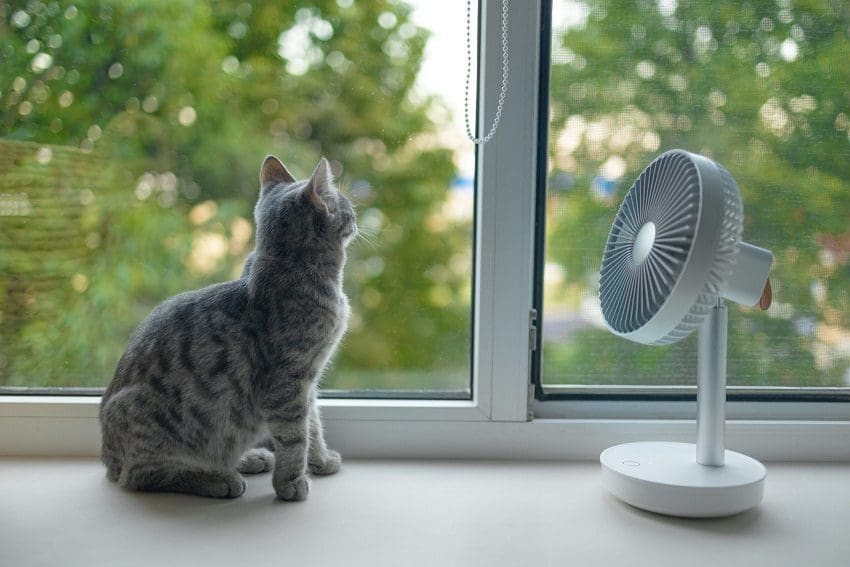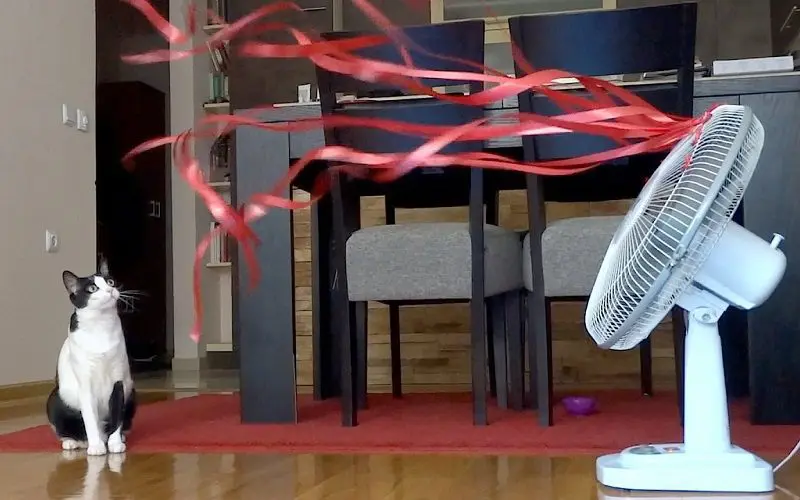Last Updated: 2 years ago
Hello, cat lovers! We all know that our feline friends can be a little cranky. But have you ever wondered, “How hot is too hot for cats?”.
Our mustachioed companions don’t just wear fur coats for fashion; they rely on them to stay cool. This article will cover the ideal temperature range for your pet’s comfort.
You’ll learn the signs of overheating to look out for and simple tips to help your cat stay cool! Let’s dive into the world of cat thermometers and make sure your furry feline stays cool as a cucumber.
What Temperature Is Too Hot for Cats?

Regarding our furry friends, ensuring their comfort is a top priority. But what temperature is too hot for cats?
Cats are just like us; they prefer the Chrysostom scenario: not too hot or cold. Generally, temperatures above 90°F (32°C) can make your mustachioed friend uncomfortable.
Signs of overheating include excessive panting, lethargy, and a desire to find a cool surface. Remember that cats cannot tell us when they are too hot.
Therefore, we must keep an eye on cats and heat. This way, your feline friend will be able to rest comfortably. At the same time, you will be happy and relaxed.
So, keep an eye on the thermostat, pamper your kitty, and together, ride out the heatwave without breaking a sweat—or a paw pad!
What temperature do cats like?
Are you curious to know what the ideal average temperature is for cats? Cats are like Goldilocks, looking for the “right” balance.
Generally, cats like temperatures between 75 and 80°F (24 and 27°C). This range reflects the cozy conditions of their desert-dwelling ancestors.
However, cats are the cooler members of the animal kingdom. They can tolerate a slightly more comprehensive range, typically 70 to 85°F (21 to 29°C).
Creating this ideal environment for a perfect cat is easy. Offer sunny spots for warmth, shady corners for coolness, and a cozy blanket or bed for sleeping.
Indoor cats especially appreciate a consistent temperature. They avoid fluctuations that can disrupt their slumbering zen.
Keeping an eye on the favorable temperature for a cat is easy. All you have to do is observe its body language. Does your cat stretch contentedly or curl up in the sunshine?
Then, most likely, you have found the optimal temperature. Remember that a happy cat often means its temperature is optimum.
Therefore, remember to adjust the thermostat, furnish an inviting environment, and you will have a content feline companion.
What Influences Their Heat Tolerance?

If you want to understand the heat tolerance of cats, you need to look into her fluffy little book.
Here’s a quick guide to what affects their ability to stay cool:
- Coat type: Cats with long, thick coats may have a harder time dissipating heat. Short-haired breeds, on the other hand, have a natural advantage in warm weather.
- Breed matters: Some breeds, such as the Persian or Maine Coon, are designed for cooler climates. At the same time, for example, Sphinxes are better able to tolerate heat.
- Age: Kittens and older cats are more vulnerable to temperature fluctuations. It can be difficult for them to effectively regulate their body temperature. They need help to regulate their temperature.
- Health conditions: Illness or obesity can affect the average temperature of cats. Regular veterinary check-ups can keep them in top condition.
- Hydration habits: Cats are not always champions of maintaining hydration. Encourage water intake, especially during the warmer months. This way, you can prevent dehydration.
- Activity level: Active cats generate more heat. Adjust play and exercise times according to the weather. This way, you can prevent overheating.
- Environment: Indoor cats like climate control. On the other hand, outdoor adventurers may need extra attention during hot periods. For outdoor cats, arrange for shaded areas and water sources.
By considering these factors, you become a knowledgeable cat care professional. You are helping to create the ideal environment for heat tolerance in cats.
It’s like being their weatherman, ensuring they always have the perfect temperature conditions.
Do Cats Get Hot?
When asked how hot is too hot for cats, people realize that cats feel the heat! Cats cannot sweat profusely.
It makes them more susceptible to overheating. When the temperature rises, they resort to alternative cooling methods.
You may notice your cat stretching out on a cool surface or seeking shade to escape the heat. Cats regulate their temperature by using areas with less fur.
These are most often the ears and paws. Indoor cats can run into problems if the house gets too warm. On the other hand, outdoor enthusiasts need careful monitoring during hot weather.
As a cat parent, it’s important to create a comfortable environment for your cat. Make sure they have access to cool places and fresh water.
Be aware of your cat’s heat sensitivity. You will help them stay calm, happy, and ready for new feline adventures.
Signs Your Cat Is Too Hot

Cats can’t yell, “It’s too hot!” like we can. But they have subtle signals telling us they’re feeling the heat.
Here are a few signs that your cool cat may be too hot:
- Shortness of breath: Excessive panting, which is unusual for cats, may indicate that they are trying to cool down. If your cat is panting heavily, this is a red flag.
- Sluggishness: Is your usually energetic fluffball turning into a lazy loaf? Then the cause could be the heat. Cats conserve energy when it’s too hot, so they don’t overheat.
- Finding cool places: Cats are intelligent thermoregulators. If cats constantly move to the coolest corners of your home and lie on cool surfaces, they are trying to beat the heat.
- elevated body temperature: Touch your cat’s ears or paws. If they feel too warm, it’s a sign that your cat has a fever.
- Decreased appetite: Hot weather can suppress a cat’s appetite. If your pet isn’t as interested in eating, they may be too hot.
- Restlessness: Cats may fidget or seem restless when they are uncomfortable. Does your cat lunge or seem agitated? Then, it may be feeling the heat.
- Excessive grooming: Cats lick themselves to maintain a favorable temperature.
Watch for these subtle hints; if you notice them, it’s time to intervene. Create a cool environment and provide your feline friend with a comfortable resting place.
How to Cool a Cat Down

Cooling down a heated cat is like giving him a spa day. Here are some simple instructions to help your feline friend relax:
- Find shade: Is your cat sunbathing in the sun? Offer her a place to rest in the shade. Shade is a natural place to cool down.
- Offer fresh water: Hydration is vital for cats, as is heat. Provide your cat with access to cool, clean water.
- The magic of a damp towel: Dampen a rag with cool (not cold) water and gently stroke the cat’s fur. It mimics the cooling effect of sweat without the cat fuss.
- Cooling mats: Purchase a cooling mat for pets. These comfortable mats absorb and dissipate heat. It will provide a comfortable place for your cat to rest.
- Ice packs (wrapped): Wrap the cold pack in a towel and place it in your cat’s favorite resting spot. Remember, there should be no direct contact between the cat and the ice.
- Ventilation: Provide an air supply to maintain the average temperature for cats. Open windows or use fans to circulate air in the house.
- Limit playtime: Cats love to play, but you should limit vigorous activity during hot periods. Save vigorous play for the evening when the temperature drops.
- Grooming: Brush your cat regularly to remove excess hair. Less hair means better heat transfer.
Remember that every cat is unique, so watch their preferences. If your cat resists a specific cooling method, try a different one.
With these simple tips, keeping your cat at a comfortable temperature will be easy!
Keeping Cats Cool: Tips

Ensuring a favorable temperature for a cat is a responsible task!
Here are some tips to keep your feline friend warm:
- Plenty of water: Keep water bowls filled with cool water at all times. Hydration is critical to staying cool. Also, drop a few ice cubes into the water bowl to refresh your cat.
- Shady shelters: Create shady corners indoors and outdoors. Cats love to take refuge in the cool when the sun gets too hot.
- Breeze time: Let a light breeze waft through your home. Open windows or use fans to keep the air circulating.
- Play wisely: Always schedule playtime for cooler times of the day. Cats love to play, but not when they are too hot.
Remember that a happy cat is a cool cat. So apply these simple techniques to keep your feline friend comfortably cool!
Conclusion
With these simple techniques, you can ensure heat tolerance for the cat.
From shady shelters to moisturizing and grooming your cat, just a few small changes can make a big difference.
Pay attention to your cat’s signals; together, you’ll survive the hot days with a purr and a smile. Here’s to happy and cool cats!
Resources:
